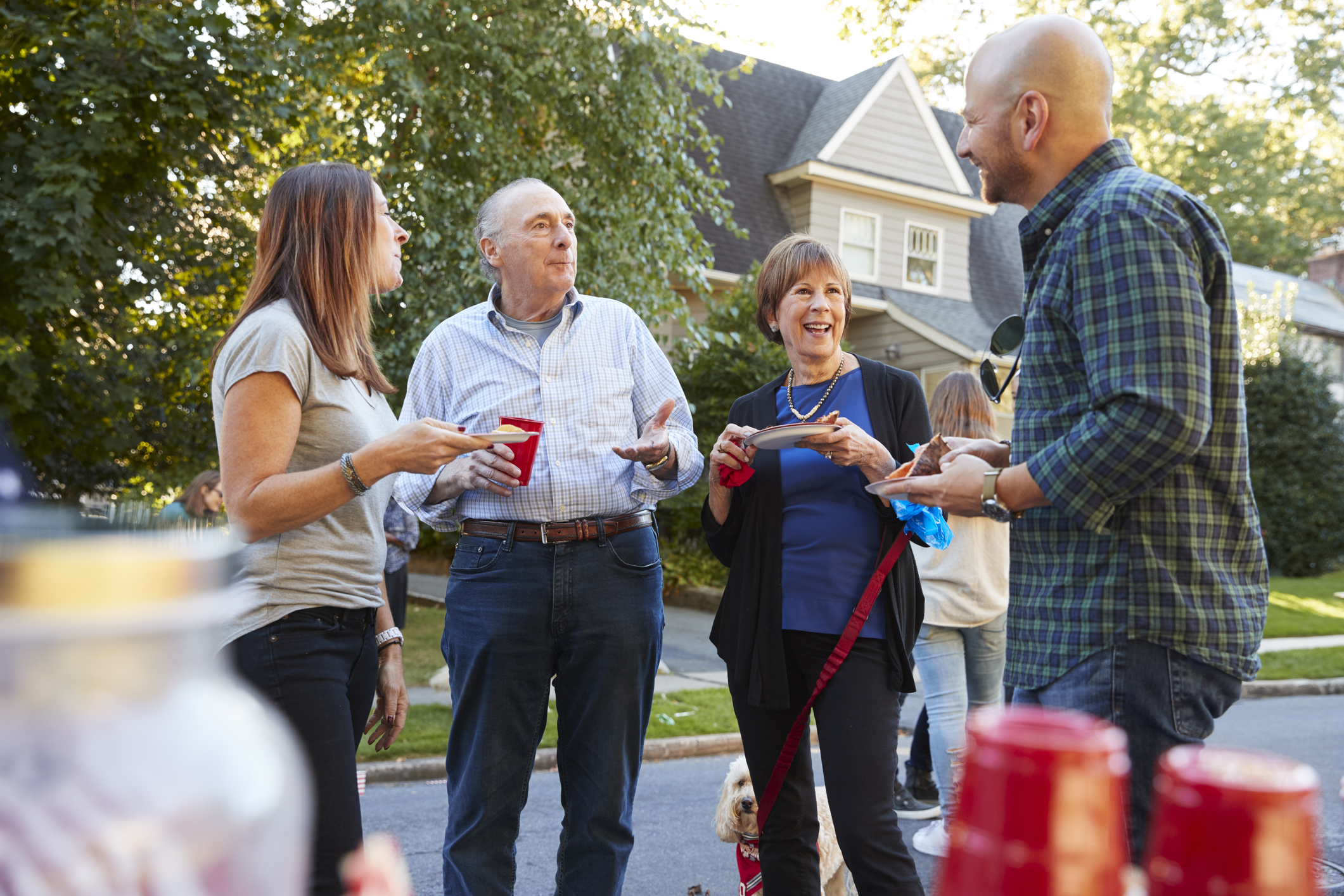Why People Like Where They Live
Robyn Driskell, PhD, Larry Lyon, PhD, and Brittany M. Fitz-Chapman, PhD
Community and individual-level factors affect the satisfaction a person derives from living in his or her community. How do we determine if a community is meeting the needs of the person, and how do we better prepare our communities, moving forward, to appeal to potential homeowners?
Our Study
Our study examined contributors to three domains of community satisfaction—overall satisfaction, social life satisfaction, and infrastructure satisfaction—from data collected across 26 communities in the United States. While terms such as ‘‘quality of life’’ or ‘‘attachment’’ are conceptually distinct, they are parallel concepts and related, we believe, to the assessment of satisfaction. For clarity, we have defined community as a place where one lives, works, networks, and most prominently identifies. Our research design included a large number of human capital variables and social capital/network variables at both the individual and community level. The focus was to identify individual- and community-level factors that influenced overall community satisfaction.
Findings & Implications
 Focusing on both individual and community contributors to satisfaction is important because, ironically, this growing interest in satisfaction with residential place occurs despite a smaller, but influential body of literature arguing that residential place doesn’t matter much anymore in an increasingly mobile, virtually networked society (Fischer 1982; Hampton and Wellman 2003; Oldenburg 1999; Wellman 2001). Interestingly enough, variations in measures similar to community satisfaction can be explained more by individual characteristics than by community context (Flaherty and Brown 2010; Guest et al. 2006).
Focusing on both individual and community contributors to satisfaction is important because, ironically, this growing interest in satisfaction with residential place occurs despite a smaller, but influential body of literature arguing that residential place doesn’t matter much anymore in an increasingly mobile, virtually networked society (Fischer 1982; Hampton and Wellman 2003; Oldenburg 1999; Wellman 2001). Interestingly enough, variations in measures similar to community satisfaction can be explained more by individual characteristics than by community context (Flaherty and Brown 2010; Guest et al. 2006).
The quality of the community, however, may have little to do with that satisfaction since local community characteristics may not matter when compared to personal characteristics. Residents derive community satisfaction from a number of factors, sometimes simply gratifying an innate need to justify the existing status quo. In examining the results of our study, essential findings can be broken down into three basic categories used across community-related applications—neutral effect, positive effect, and negative effect.
Homeownership had a neutral impact overall, showing positive and negative associations dependent upon the test group being examined. As the variation in opinion on this factor is related to each associated multi-level model, we find it best to alternatively examine positive and negative effects for implications.
Of the factors promoting a positive impact, bridging social capital and networks seemed to be the most prominent. Those surveyed place high importance on the number of friends and family members living nearby as well has having open communication with their neighbors. Higher median incomes for individuals/communities along with higher levels of volunteer-oriented service also contributed to overall community satisfaction. The traditional idea of community in the technological age may translate better than we think—people continue to seek residency in communities that foster interpersonal and intercommunal growth.
Negative impacts were primarily evident in two community-level factors: communities with insufficient infrastructure and densely populated communities. Insufficient infrastructure, such as lower quality roads, schools, and parks, influence homeowners’ perceived value of their homes. Homeowners may be more critical of the local infrastructure and have higher expectations due to their own level of investment (Roskruge et al. 2012). Densely populated communities can often place a strain on this infrastructure, decreasing its quality and thus contributing to negative overall community satisfaction.
Application to Real Estate
When acquiring homes for your agency to sell, look for communities that can foster growth for your potential clientele base. High quality in community life can be seen in thriving communities with well-designed infrastructure and an engaging sense of community. Potential homeowners seek out cultural epicenters that support the arts and the social life that surrounds them. The neutral (or sometimes negative) association with homeownership can be negated by a community that provides social opportunity for its residents. Search for houses in these communities that can incentivize prospective homeowners.
On an individual level, promoting social initiatives in your local community can encourage others to desire entry. Potential homeowners seek communities that make them feel “good.” Agents can begin by improving their own communities to draw others in. These actions benefit the overall community satisfaction of prospective homeowners along with the agents themselves. Incentivize potential customers in your market through providing an example of positive community activity.
When segmenting your target market for promotion, there are two human capital/demographic variables that are consistently positive: being female and being an older adult. These segments show higher levels of satisfaction across all three domains of community. Successfully marketing to these segments creates the potential for a smoother sales process. Maintaining these relationships may increase word-of-mouth promotion from these customers, leading to repeat sales in the same community. Why sell a single home when you could sell a community?
Conclusion
 While a number of factors contribute to the level of satisfaction residents feel toward their community, the nuances of variation by domain and context make broad generalizations difficult. Indeed, a major finding from this research is the complexity associated with answering the straightforward question of why people like where they live. Community-level measures matter, but they often influence satisfaction in ways quite different from their individual counterparts. Though more research is needed to fully understand why we like where we live, the implications of our study can be used as a guide for understanding how individuals define overall satisfaction in their communities.
While a number of factors contribute to the level of satisfaction residents feel toward their community, the nuances of variation by domain and context make broad generalizations difficult. Indeed, a major finding from this research is the complexity associated with answering the straightforward question of why people like where they live. Community-level measures matter, but they often influence satisfaction in ways quite different from their individual counterparts. Though more research is needed to fully understand why we like where we live, the implications of our study can be used as a guide for understanding how individuals define overall satisfaction in their communities.
. . . . . . . . . . . . . . . . . . .
Recommended Reading
Fitz, Brittany M., Larry Lyon, and Robyn Driskell (2016), “Why People Like Where the Live: Individual- and Community-Level Contributors to Community Satisfaction,” Social Indicators Research, 126(3), 1209-1224.
. . . . . . . . . . . . . . . . . . .
References
Fischer, Claude S. (1982), To dwell among friends: Personal networks in town and city, Chicago, IL: University of Chicago Press.'?'
Flaherty, Jeremy and Ralph B. Brown (2010), “A multilevel systemic model of community attachment: Assessing the relative importance of the community and individual levels,” American Journal of Sociology, 116(2), 503-542.'?'
Guest, Avery M., Jane K. Cover, Ross L. Matsueda and Gharis E. Kubrin (2006), “Neighborhood context and neighboring ties,” City and Community, 5(4), 363-385.
Hampton, Keith and Barry Wellman (2003), “Neighboring in netville: How the internet supports community and social capital in a wired suburb,” City and Community, 2(4), 277-311.
Oldenburg, Ray (1999), The great good place: Cafes, coffee shops, bookstores, bars, hair salons, and other hangouts at the heart of a community, Washington, DC: Marlowe & Company.'?'
Roskruge, Matthew, Arthur Grimes, Philip McCann and Jacques Poot (2012), “Social capital and regional social infrastructure investment: Evidence from New Zealand,” International Regional Science Review, 35(1), 3-25.
Wellman, Barry (2001), “Physical place and cyberplace: The rise of personalized networking,” International Journal of Urban and Regional Research, 25(2), 227-252.'?'
. . . . . . . . . . . . . . . . . . .
About the Authors
Robyn Driskell, PhD
Professor of Sociology, Vice President and Chief of Staff, Baylor University
Dr. Robyn Driskell (PhD – Texas A&M University) is Vice President and Chief of Staff to the President at Baylor University. Previously she served as the Divisional Dean of Humanities and Social Sciences in the College of Arts and Sciences at Baylor University. She also served as the Department of Sociology’s Graduate Program Director, where she was recognized as Outstanding Graduate Program Director by the Graduate School. She has taught a variety of courses, including Introduction to Sociology, Community Sociology, Demography, Population Problems, Marriage and the Family, and Applied Sociology, and recognized as Outstanding Professor in Teaching by the University. Dr. Driskell’s area of specialization and primary research interests are community, demographic trends, and race and ethnic studies. Her scholarly books include The Community in Urban Society with Larry Lyon and The Discourse on Applied Sociology with Samir Dasgupta. She is also the author of numerous peer-reviewed journal publications and book chapters and has received external grant funding for community research.
Larry Lyon, PhD
Director of the Center for Community Research and Development, Vice Provost, Dean of the Graduate School, and Professor of Sociology, Baylor University
Dr. Larry Lyon’s (PhD – University of Texas at Austin) research has been in the field of local politics and community development. Since becoming Dean of the Graduate School in 1998, he has published several articles based on his research concerning the challenges and opportunities associated with faith-based higher education. Dr. Lyon has served as Chair of the Baylor Faculty Senate and President of the Southwestern Sociological Association, the Southwestern Social Science Association, and the Texas Association of Graduate Deans. He is currently on the Executive Board of the Council of Southern Graduate Schools.
Brittany M. Fitz-Chapman, PhD
Director of Data and Research, Prosper Waco
Dr. Brittany Fitz-Chapman (PhD – Baylor University) coordinates all data collection for Prosper Waco, a new organization dedicated to improving the health, financial security, and education of Wacoans. She also assists with the creation of a "community scorecard," directly applying her training and expertise gained through time at Baylor University. Brittany joins the large and impressive group of Applied Sociology graduates who use their research skills to tangibly improve the lives of real people around the world.